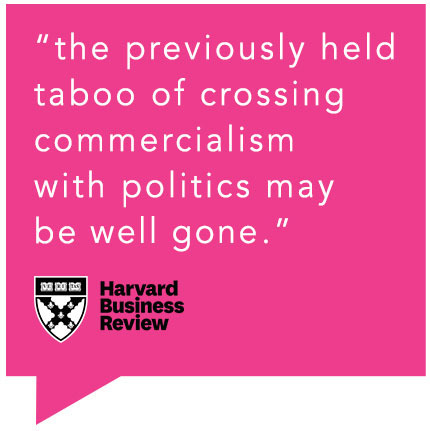Whether you’re in one camp, the other or completely over it, we can (probably?) agree on one thing—the U.S. and its consumers are amidst one of the most divisive and tension-filled periods in recent history.
Lines have been drawn, “friends” get un-friended and wearing a mask is a political statement. It isn’t easy and likely won’t change on Election Day in November when one group or the other is livid.
Brands looking to ingratiate themselves with consumers are left (and right) to think long and hard about how and whether to engage in conversations your mother told you were unfit for polite company. But staying away from increasingly politicized issues isn’t that easy and may not even be advisable—particularly for brands looking to define their purpose.
THE CHANGING POLITICS OF BRANDING
The days of brands living in a political, or at least issue-based, bubble have been over for a while.
In fact, many challenger brands have built themselves on the very cultural, environmental and even religious causes that make up the talking points on both sides of the aisle.
Modern brand strategy suggests that challenger brands win by aligning themselves more closely with a particular type of consumer than the behemoths. It’s not the only factor in overcoming bigger marketing budgets and better distribution, but it’s certainly a foothold that has been proven successful. And while aligning yourself with a political ideology or hot-button issue has long made brand managers sweat, recent studies and success stories have shown it to be increasingly expected.
A Harvard Business Review study took on the issue of how consumers feel when companies get political and found that while women reacted more negatively to political activity by brands, the overarching conclusion was that “the previously held taboo of crossing commercialism with politics may be well gone.”
Bottomline…consumers are getting used to brands aligning themselves with the types of lightning rod causes that are currently dominating the news…And while it may seem prudent to stay neutral, the middle ground becomes less and less safe for brands looking to remain relevant. This is particularly the case for challenger brands looking to unseat incumbent category leaders.

Only careful consideration—and consumer research—can truly answer the question of whether your brand should take up politically charged issues, whether they be around the environment, race, religion or something even more niche.
However, the following points are worth considering as you negotiate the divide.
IDENITIFY YOUR PLATFORM AND BE PREPARED TO TAKE ACTION
Winning over consumers requires an authentic commitment to the cause you choose and should be aligned with the differentiating value of your brand.
If you’re going to risk getting behind something that could alienate certain audiences, it should be something that serves as a platform to clearly set you apart from the competition—something that defines why you exist in the first place.
Then make a difference—not a social post.
KNOW THE VOTER YOU ARE LOOKING TO ATTRACT
Brands must look carefully at their real or desired constituency (buyer) and understand the causes that matter most to THEM.
We’ve read plenty of stories about brands whose political affiliation or giving campaigns stem from the beliefs of the founder. Only one rationale has a shot at trumping what the boss, founder or board believes—hard data that a different one may drive profits.
ALIGN YOUR BRAND WITH ISSUES—NOT INDIVIDUALS
There is inherent risk in hanging your brand’s place in the conversation on a particular candidate, politician or leader of a movement. Leaders change, lose elections and engage in behaviors that are contradictory to the causes you are looking to support.
Carve out your place in the conversation and align with issues and organizations that are sustainable. There are instances where brands advanced by backing personalities—but it is inherently more risky.

INVOLVE YOUR CONSTITUENCY TO DRIVE RELEVANCE
Consumers know brands exist at their core to sell them things. Shallow cause campaigns do little to sway an increasingly aware and subsequently distrustful consumer population.
Brands looking to join the conversation must use their fans, consumers and even employees to showcase what they believe—and how they are living it every day. Templated press releases on intentioned commitments will fail to connect the dots for consumers.
BE PREPARED FOR A VERY LOUD MINORITY
Brands—particularly challengers—cannot be all things to all people.
Those that base their brand on a particular issue or engage in cause campaigns must be prepared for some level of backlash and questioning from those with a differing viewpoint. It will happen.
Ensure your communications team has the tools they need to politely but exactly explain your position while acknowledging the viewpoints of others. You’d be surprised what a little empathy can overcome.
